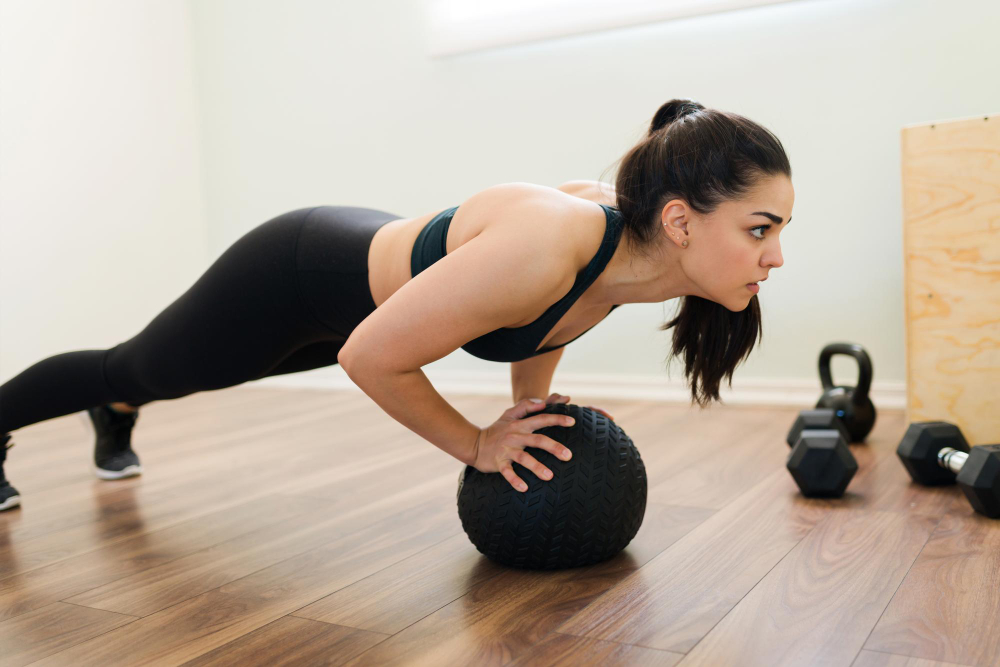Functional training - what is it and what benefits does it bring?

Functional training includes exercises that support the body while performing activities of daily living. Most often, they involve different muscle parts, allowing you to increase overall strength, endurance, flexibility, balance and strengthen muscles. Functional exercises can be performed in virtually any environment - at the gym, at home, in a fitness club or even in a park.
What is functional training?
Over the past few years, functional training has become very popular. It is often even an important part of the training plan of athletes. It is also recommended for the elderly, people who lead a sedentary lifestyle, as well as for patients after surgery or stroke.
What is functional training? In a nutshell, it is the imitation of the movements we make during our daily activities. As a result, during training, we do not work on a specific muscle, but perfect the entire movement, which involves multiple muscle parts and joints. We focus on the whole activity without dividing it into basic movements. Regular functional training improves coordination and balance in daily life and contributes to strength and endurance.
Functional training and standard training
Traditional training methods involve intense exercises focused on specific muscles. With regular training and high loads, the endurance of a given muscle and its strength increase relatively quickly. However, the functional movements we perform during activities of daily living and during sports competitions usually involve more than one muscle. Let's do them in different conditions, often without support, and not in a fixed position. For this reason, traditional training methods, which are based on classical movement patterns, mainly focus on the growth of muscle mass. Their goal is definitely not to comprehensively strengthen muscles in daily life.
Attitudes of functional training
Functional training is very different from classic gym exercises. Its goal is to improve the comfort of daily life and generally increase mobility and coordination of the body. When performing functional exercises, the most important thing is the natural movement of muscles and joints, which reflects the movements performed on a daily basis.
During functional training, we can build so-called integrated movement patterns, i.e., movements involving the whole body that mimic everyday activities, such as bending down to get groceries, sitting on a chair, reaching for an object from a shelf, lifting a pack of water.
What does functional training look like?
In functional training, we limit the performance of movements focused on isolated muscle groups. We also give up using machines and focus on activities with the weight of our own body. During some exercises, we use simple weights, such as dumbbells, kettlebells, medicine balls, TRX bands or exercise bands.
During training, the most important thing is the variety of exercises performed. Very often modern fitness clubs are equipped with instruments that diversify functional training. In addition to the aforementioned accessories, barbells, hurdles, muscle bands, coordination ladders, steppers and BOSU half-balls are also worthy of special attention.
Benefits of functional training
Unlike standard gym training, functional exercises do not contribute to visibly expanding muscle mass. Instead, they strengthen the body and prepare it to perform various movements, so we can move more confidently and everyday activities are performed by us smoothly. During exercise, we focus primarily on complex body movements, which are usually not developed by classic resistance training.
Regular functional training can reduce risk of injury on a daily basis. It also improves flexibility and coordination of movement, and provides strong muscles. The fast pace of exercise during functional training contributes to the body's fitness and also improves blood circulation.
What's more, functional exercises also rely on the work of deep muscles, which are responsible for maintaining correct posture. Thus, functional training can reduce joint pain and back pain.
Recommended products
Where to start?
Functional training and the type of intensive exercises we do should always be tailored to the needs and capabilities of the person training. Very often even before starting exercises, it is recommended to perform FMS test, which is a functional movement test. During the test it is possible to detect abnormal movement patterns. We can also identify existing body asymmetries.
The FMS test involves assessing movement patterns based on how we perform specific exercises. Exercises evaluated include the deep squat, active lower limb extension, trunk stabilization, rotational stability, shoulder girdle mobility, and leg transfer over the crossbar.
Functional training - where to train?
The undoubted advantage of functional training is that we can practice it virtually anywhere. At gyms and fitness clubs, we can increasingly sign up for special functional classes, during which the instructor will offer us a diverse training plan, give us the necessary tips, and correct any mistakes.
Very often, functional training classes are divided into stations. The trainer lays out the equipment in the room, and the participants' task is to perform the exercises one by one on each piece of equipment. This way, every exerciser has a chance to do all the exercises.
Beginners also very often opt for individual sessions with a personal trainer. During such training, the instructor may offer us a series of exercises tailored to our needs and skills, and will show us how to use the accessories available at the gym.
More and more people are also opting for functional training at home. There are a lot of videos and articles on the internet with exercise suggestions. When training at home, technique is very important. Improper exercise may, instead of increasing fitness, result in injury.
\Examples of functional exercises
During functional training, the variety of individual exercises is very important. The most common exercises, also among beginners, are the following:
- plank - front support is an exercise that strengthens the deep muscles of the abdomen, trunk and pelvis. It involves supporting the torso on the forearms. During the exercise, the arms should be bent at right angles, while the shoulders should be exactly below the elbows.
- side support - this type of exercise activates virtually the entire body, including the gluteal, abdominal, back, thigh and biceps muscles. The exercise involves laying the body sideways and supporting it on the forearm; the arm should be perpendicular to the ground.
- squats - this is a typical functional exercise engages various muscle groups used, for example, when sitting on a chair; in functional training, different variants of this exercise are popular, such as squats with barbells, squats on one leg or squats with a squat involving active lifting of the straight leg, after the squat is performed, return to the starting position.
- maintaining balance - this simple exercise that activates the whole body can be performed both on equipment (BOSU ball, balance beam) and without additional accessories (on one leg).
A very important part of the exercises are also two-handed tasks. Such movements aimed at daily activities involving both hands help exercise coordination of the two sides of the body.

Functional training - how to exercise?
During functional training pace and progressive difficulty of the exercises are particularly important. It is these elements of functional training that gradually strengthen the muscles. Typically, individual activities are performed in short bursts with multiple repetitions that last from 45 to 90 seconds. One series is one exercise. It is also worth betting on a random arrangement of exercises. Also extremely important are accessories that support training, such as medicine balls, bands, kettlebells, which increase the effectiveness of exercises.
Functional training as a form of medical rehabilitation
Specialized functional training under the guidance of an experienced specialist can also be a form of medical rehabilitation. Its effect is not only to strengthen muscles, but also to restore control and function of the neuromuscular system, which is particularly important for those struggling with impaired motor skills.
Functional training not only contributes to muscle strengthening, but also amounts to a number of additional benefits. It can improve our balance and coordination during daily activities and reduce the body's vulnerability to damage and injury.
Sources:
- https://eurapa.biomedcentral.com/articles/10.1007/s11556-014-0144-1
- https://www.ncbi.nlm.nih.gov/pmc/articles/PMC6873344/
- https://scholarship.shu.edu/cgi/viewcontent.cgi?article=1098&context=dissertations
- https://www.frontiersin.org/journals/physiology/articles/10.3389/fphys.2021.738878/full
- https://www.sciencedirect.com/science/article/pii/S1728869X10600172
- https://journals.lww.com/nsca-jscr/fulltext/2019/03000/effects_of_8_week_functional_vs__traditional.7.aspx

